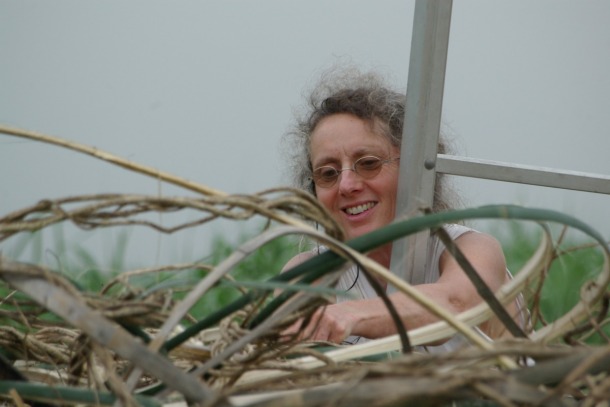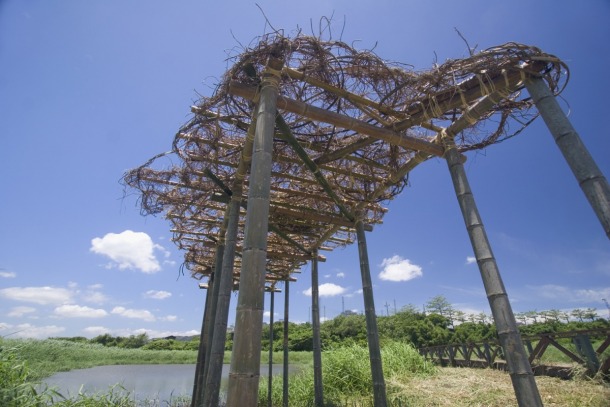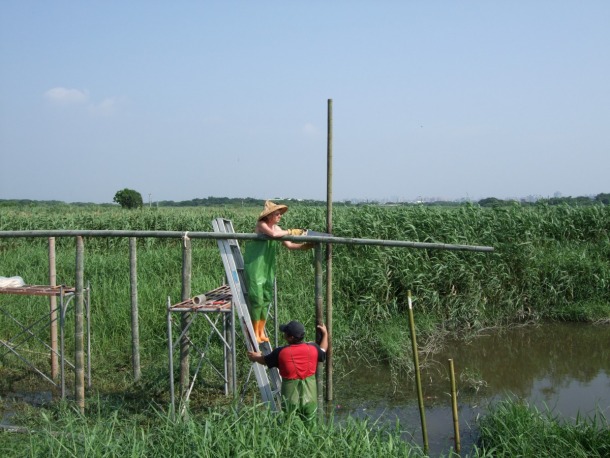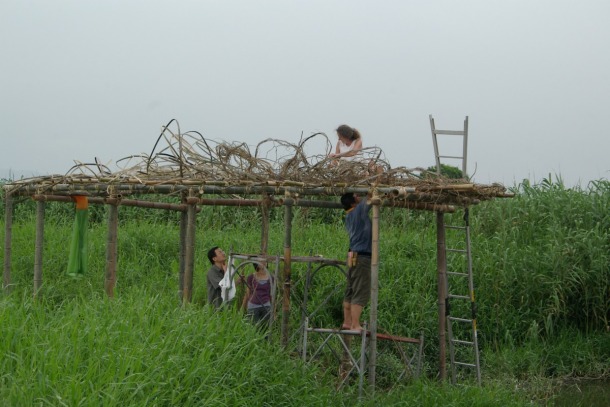凱倫.麥考伊/美國
冥想的極限空間:台灣迷津
竹子、繩索、藤蔓或柳樹枝
Karen McCoy/USA
Space for Contemplating Carrying Capacity: The Taiwan Tangle
bamboo, rope, vine or willow
創作經歷
麥考伊過去20多年來主要的作品都是大型戶外空間的雕塑,她的作品基於多年來對地理文化和社會歷史的深入研究,強調自然與文化的關係,涵蓋影音、攝影、繪畫、拓印。最近期的作品陳列於佛羅里達州的基韋斯特園。2007她得到亞洲文化委員會為期三個月的獎助金,在日本從事文化與景觀和建築風格的關係研究。在進修期間,於加州柏克萊藝術學院擔任研究員,從事四個月的數位科技研究。在2003年在國家藝術基金會贊助的路易斯克拉克二百年特展中,由她擔任首席藝術家。
麥考伊也獲得其他獎助金,得以於美國加州、伊利諾州、麻州、密蘇理州、羅德島、南卡羅來納、德州、懷俄明州等地從事創作。她接受過安迪•沃荷等基金會的贊助,也曾經是美國、日本東京「遊工房」藝術中心、法國等地的駐館藝術家。
麥考伊於1994年開始任教於肯薩斯學院雕塑系擔任副教授,並於1994到2003年擔任系主任。
Karen McCoy’s primary work for the last two decades has been large-scale, publicly sited environmental sculpture. McCoy focuses on the relationship of nature to culture, creating work based on extensive research into the geological, cultural, and social histories of each site. She also works in video, photography and makes drawings and prints. Her most recent installation was for Sculpture Key West in Florida. In 2007 she received a three-month grant from the Asian Cultural Council to conduct research in Japan on the relationship of culture, landscape, and built form. She also was a fellow at the KALA Art Institute in Berkeley, CA, studying digital technology four months during this sabbatical. In 2003 she was selected as lead artist for the Lewis and Clark Bicentennial project, funded by the National Endowment for the Arts. Other grants and commissions have allowed her to create work in France, Denmark, and Lithuania and in the U.S. in California, Illinois, Massachusetts, Missouri, Rhode Island, South Carolina, Texas and Wyoming.
Ms. McCoy has received support from the Andy Warhol Foundation, Artslink, and the Art Association/Land Trust of Jackson, Wyoming. She has had numerous residencies, including the Tokyo Wonder Site and Youkobo Art Center, Tokyo, Japan; the Camargo Foundation, Cassis, France; the Ucross Foundation in Wyoming, and the Djerassi Foundation, Woodside, California.
Karen McCoy is an associate professor of art in the sculpture department at Kansas City Art Institute, where she has taught since 1994, serving as chair of the department from 1994 to 2003.
創作理念
「冥想的極限空間:台灣迷津」是兩棲的,在水裡也在陸上。頂端是由竹子作的框架,並以草木交織出一幅台灣的圖像。這是以飽合容量為主題的冥想,從環保者的角度來看,它意味著以有限的自然資源為前題,在一定的範圍之內,以不破壞現有及未來的自然、社會、文化及經濟的大環境之下,所能養活的人數。冥想的極限空間代表著全球所面臨的窘境,像台灣這樣的小島上更能凸顯它的特質。每個人都可以佇足於水邊,再折返到原來的出發點,就這樣來回直到冥想終結。
這裡的子題是「台灣迷津」,就像我們頭上糾結的屋簷,亂糟糟的一團,看起來像「烏雲」一般的籠罩在我們的頭上。然而將視線穿過糾纏不清的背後,似乎又可從縫隙間瞥見藍天的掠影。整體的結構隱喻著我們的家,提供我們一個喘息的空間和庇護之所。但是唯有用心的呵護才能享受它的溫暖。我們的家園,也就是這個地球,正遭逢了空前的威脅。當我們逐漸逼近飽合容量的極限時,這些實體的糾纏呈現出了眼前各種挑戰的複雜度。這是渾沌的實質體驗,也具體的反應出我們的心境。人類現有的心智還搞不清楚如何收拾我們對環境所造成的殘局。
在我們與地球的相互關係之中,目前並沒有一個很好的平衡。台灣曾快速的經歷了從農業化邁入工業化的轉型,面對新舊之間的迷失,也存在了尊敬大地與濫用資源的矛盾。最缺乏的是對於我們處在這樣的危機當中的認知,更遑論積極的承擔應有的責任。 我們可以努力的打造出對地球傷害降到最低的生活方式,或者我們也可以選擇去忽略他。這一個裝置藝術想要喚起大家對於空氣、大地、和水的重視,以及我們與這三者之間的關聯,提供一個空間,讓大家好好的來思考這些事情。
Statement
Space for Contemplating Carrying Capacity: The Taiwan Tangle will be located on land and in water. The roof will be supported by bamboo posts and constructed of tangled vegetation in the shape and proportions of the island of Taiwan. The sculpture is created for meditation on the subject of carrying capacity, a term environmentalists describe as “the number of individuals who can be supported in a given area within natural resource limits, and without degrading the natural, social, cultural and economic environment for present and future generations”. Carrying capacity refers to a worldwide dilemma that is intensified on a small island like Taiwan. Walking meditation will take place on a pathway within the structure. Each individual will stop at the water’s edge, reverse their course and continue this back and forth until they have finished with the meditation.
The subtitle, Taiwan Tangle, refers to the tangle of the shade roof over our heads. The tangle is like a “dark cloud” hanging over all of us, but through it we can see glimpses of blue sky. The structure itself is a metaphor for home, a place that may provide us with respite and protection, but only so long as we take care of it. Our home, the earth, is threatened. The tangle is a physical representation of the complexity of the problems that face us as we push the limits of carrying capacity. It is a physical representation of chaos, a physical manifestation of our mental state. Our minds are not clear on how to respond to the conditions we have caused for our air, water and soil. Mindfulness, as in meditation, of the tangle provides for the possibility of change. In our reciprocal relationship with the earth, there is presently an imbalance. Taiwan itself has undergone a rapid transition from being an agrarian place to being an industrial place. There is confusion between old and new, between honoring the earth and abusing it, and a lack of understanding and active recognition about the part each of us plays in this current crisis. We can attempt to live in such a way as to reduce our harmful effect on the earth, or we may choose to ignore it. This work intends to focus attention on air, land, water and our own relationship to them. The sculpture provides a space for individuals to contemplate these issues.





